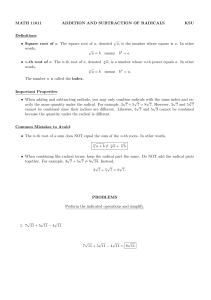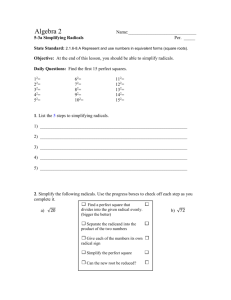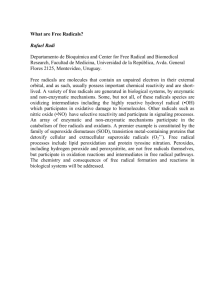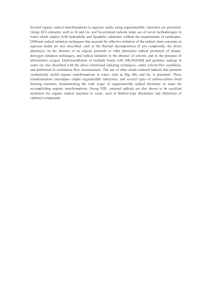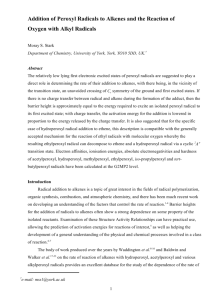MATH 11011 MULTIPLICATION OF RADICALS
advertisement
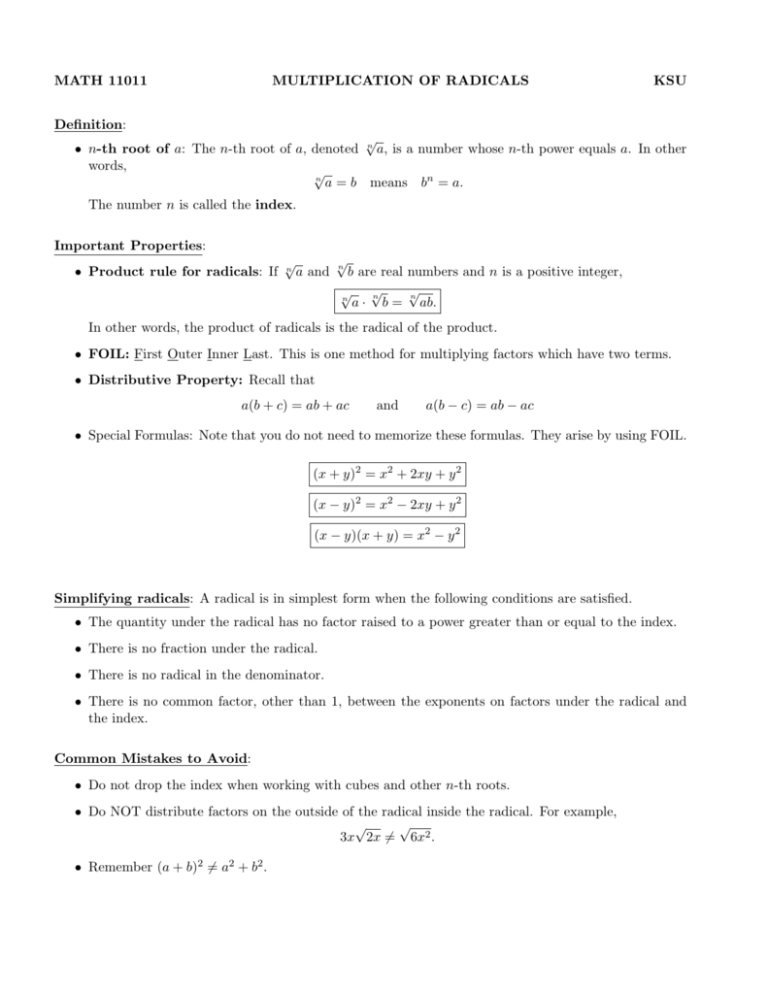
MATH 11011 MULTIPLICATION OF RADICALS KSU Definition: √ • n-th root of a: The n-th root of a, denoted n a, is a number whose n-th power equals a. In other words, √ n a = b means bn = a. The number n is called the index. Important Properties: • Product rule for radicals: If √ √ n a and n b are real numbers and n is a positive integer, √ √ √ n n n a · b = ab. In other words, the product of radicals is the radical of the product. • FOIL: First Outer Inner Last. This is one method for multiplying factors which have two terms. • Distributive Property: Recall that a(b + c) = ab + ac and a(b − c) = ab − ac • Special Formulas: Note that you do not need to memorize these formulas. They arise by using FOIL. (x + y)2 = x2 + 2xy + y 2 (x − y)2 = x2 − 2xy + y 2 (x − y)(x + y) = x2 − y 2 Simplifying radicals: A radical is in simplest form when the following conditions are satisfied. • The quantity under the radical has no factor raised to a power greater than or equal to the index. • There is no fraction under the radical. • There is no radical in the denominator. • There is no common factor, other than 1, between the exponents on factors under the radical and the index. Common Mistakes to Avoid: • Do not drop the index when working with cubes and other n-th roots. • Do NOT distribute factors on the outside of the radical inside the radical. For example, √ √ 3x 2x 6= 6x2 . • Remember (a + b)2 6= a2 + b2 . Multiplying radicals, page 2 PROBLEMS Multiply each product. Write all answers in simplest form. √ ¡ √ ¢ 1. 3 2 5 3 − 4 √ ¡ √ ¢ 3 2 5 3−4 √ √ 15 6 − 12 2 √ ¡ √ √ ¢ 2. 5x 3 9 2 3 3 − 6 3 9 √ ¡ √ √ ¢ 5x 3 9 2 3 3 − 6 3 9 √ √ 10x 3 27 − 30x 3 81 √ 3 10x · 3 − 30x 27 ·3 √ √ 3 3 30x − 30x 27 3 √ 3 30x − 90x 3 ¢¡ √ ¢ ¡ √ 3. 3 5 + 2 2 5 − 7 ¡ √ ¢¡ √ ¢ 3 5+2 2 5−7 √ √ √ 6 25 − 21 5 + 4 5 − 14 √ √ 6 · 5 − 21 5 + 4 5 − 14 √ √ 30 − 21 5 + 4 5 − 14 √ 16 − 17 5 4. ¡√ ¢2 8−3 ¡√ ¢2 8−3 ¡√ ¢ ¡√ ¢ 8−3 8−3 √ √ √ 64 − 3 8 − 3 8 + 9 √ √ 8−3 8−3 8+9 √ 17 − 6 8 √ 17 − 6 4 · 2 √ √ 17 − 6 4 2 √ 17 − 6 · 2 2 √ 17 − 12 2 √ ¢2 ¡ √ 5. 2 3 + 6 √ ¢2 ¡ √ 2 3+ 6 √ ¢¡ √ √ ¢ ¡ √ 2 3+ 6 2 3+ 6 √ √ √ √ 4 9 + 2 18 + 2 18 + 36 √ 4 · 3 + 4 18 + 6 √ √ 12 + 4 9 2 + 6 √ 18 + 4 · 3 2 √ 18 + 12 2 ¡ √ ¢¡ √ ¢ 6. 3 5 − 4 3 5 + 4 ¢¡ √ ¢ ¡ √ 3 5−4 3 5+4 √ √ √ 9 25 + 12 5 − 12 5 − 16 9 · 5 − 16 45 − 16 29 Multiplying radicals, page 3 7. ¡√ ¢ ¡√ ¢ 7+2 2−4 ¡√ ¢ ¡√ ¢ 7+2 2−4 √ √ √ 14 − 4 7 + 2 2 − 8 √ ¢¡ √ √ ¢ ¡ √ 8. 2 8 − 3 2 48 − 2 √ ¢¡ √ √ ¢ ¡ √ 2 8 − 3 2 48 − 2 √ ¢¡ √ √ ¢ ¡ √ 2 4 · 2 − 3 2 16 · 3 − 2 √ √ ¢¡ √ √ ¢ ¡ 2·2 2− 3 2·4 3− 2 √ ¢¡ √ √ ¢ ¡ √ 4 2− 3 8 3− 2 √ √ √ √ 32 6 − 4 4 − 8 9 + 6 √ √ 32 6 − 4 · 2 − 8 · 3 + 6 √ √ 32 6 − 8 − 24 + 6 √ −32 + 33 6 NOTE: You could also have multiplied using FOIL first and then simplified your answer.

